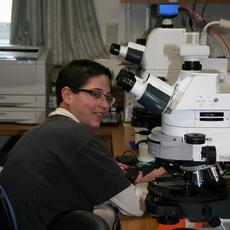Timescales on board of the Chikyu
Living in darkness at the oceans’ depths, the evolution of microorganisms there might go all but unnoticed were it not for the likes of biostratigrapher, France Girault, doctoral student at ETH Zurich’s Institute of Geolology. Writing from the Integrated Ocean Drilling Project (IODP) drilling vessel, “D/V Chikyu”, Girault describes her work investigating sediments off the coast of Japan.
For over 4 weeks now I have been working and
living on the IODP drilling vessel, the 210 meters long “D/V Chikyu”, along
with 150 other people among whom are scientists, lab technicians, engineers and
crew members. We are participating in the IODP Expedition 316 and currently
drilling our second site in the “Nankai Trough” off the southwest coast of Japan.
My role on the ship is to analyze fossils in order to determine the approximate
age of the recovered sediments and rocks.
Around the clock
Drilling operations and scientific analyses take
place around the clock. Half of the ship’s personnel are on duty between noon
and midnight; the other half between midnight and noon. Onboard it really
resembles a two-way street. At
midnight, on my way to the laboratory wing, I meet worn-out
crew members or colleagues on their way to dinner. To their ‘Good Evening’, I
reply ‘Good Morning’ because I am still too asleep to realize what time it is. Once
I reach the lab, my colleague from China, the micropaleontologist Xin
Su, gives me a quick summary of the day’s results, and briefs me on the latest
news and activities. Together we review the sample on which she has most
recently worked. The end of this short hand-over
meeting marks the start of my shift. I will be up and alone in the lab for the
next 12 hours, actively taking core materials, preparing samples and determining
how old these sediments are.
Dating sediments
Xin and I are the lone micropaleontologist and biostratigrapher on this trip and the first to get samples from the cores that arrive fresh on deck. Searching and analyzing microfossils in the sediment is our daily job. Because these microfossils are so diverse, we each concentrate on particular aspects of the fossils. Xin is the expert on nannofossils, whose hard calcareous shells are used in building materials. I am the expert on radiolarians and diatoms, two microfossil groups that create their shells out of opal.
These microorganisms are still living in today’s oceans, though with time some have undergone stark change. Some of these organisms have evolved into one or more new species while others have become extinct.
After decades of work in retrieving sediments from all historical time periods, scientists have been able to establish when particular species from various groups have both appeared and disappeared. The “range charts” developed by scientists summarise occurrence intervals of various species within each group of microfossils and are also calibrated with other time records (e.g., magnetostratigraphy).
Each day I identify the radiolarian and diatom content of every new sample, trying to get a first age estimate. Xin does the same with samples during her shift. When one microfossil group is not represented in the samples, or some of the key species are missing, we have to combine data with other fields in order to give an age estimate as best as we can. The more data we get, the more precise the age estimation can be. The first age estimate for the sediment is very important for all of the scientists onboard in order to be able to ascertain in the disturbed domains of the sediment which sediments appear where, or are missing completely.
Understanding the geologic history
On our last site, the age estimate of downhole sediments actually showed that the sediments directly below the Megasplay Fault, are younger than the sediments above them. This difference in age sheds some light on the displacement rate in this region, a crucial detail that helps to better understand the earthquake mechanics and tectonic evolution of the Nankai Trough.








READER COMMENTS